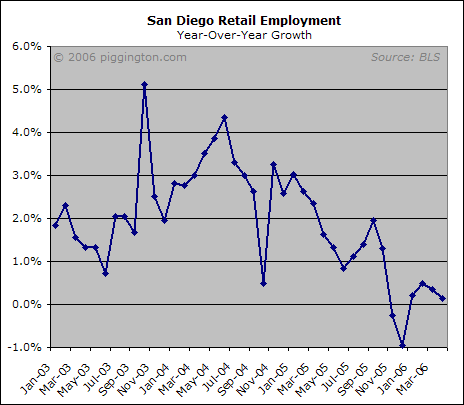The party is officially over. This is no great surprise, and we’ve seen it coming for months. But what’s different now is that there is no longer any question that the home price downturn has begun.
At the beginning of 2005, we were in a situation where prices had been flat since the summer, inventory had risen substantially, and sales volume was down. Things didn’t look terribly promising for the market. But rates remained fairly low, and lenders tried to drive more volume by pushing non-traditional mortgage products that lowered initial monthly payments. The resulting bump in demand fed a little spring rally, and the spring of 2005 actually saw a bit of a rise in median home prices.
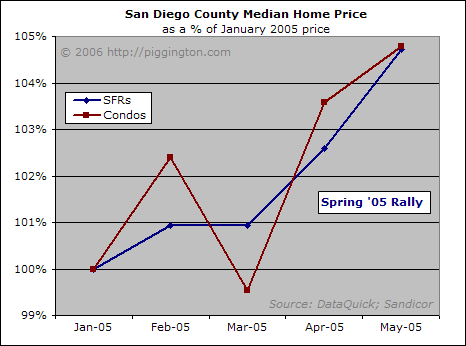
Median prices flattened out in the second half of 2005, and it certainly appeared to be the end of price appreciation for San Diego. But that lingering doubt remained… would there be another spring rally in 2006? I started to doubt as much when ARM rates really started to skyrocket at the end of 2005:
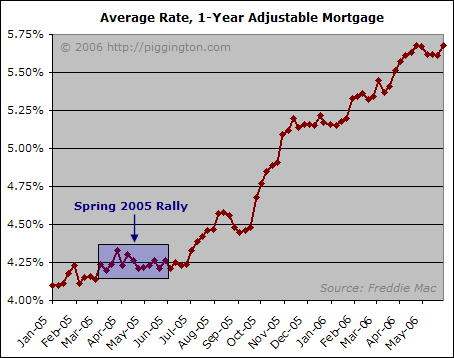
After the big spike in November, I became fairly convinced that unless ARM rates started to fall again, no spring rally was forthcoming. Well, not only did rates not fall, they continued upwards to hit multi-year highs. It sure looked like the spring rally was doomed.
And doomed it was. The SFR median flatlined, and the condo median has actually declined year-to-date despite the typical seasonal strength.
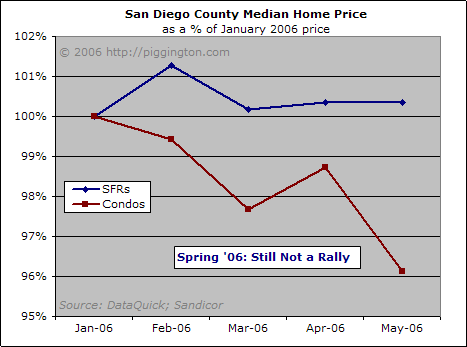
There is a difference between suspicion and certainty, and now that we are heading into summer it is very clear that no spring rally ever took place. Those hoping that the housing bubble might inflate a bit more have had their hopes dashed. The market has now spent an entire year moving in the flat-to-down direction: the following graph shows that the median single family home price has gone absolutely nowhere in the past year, and that the median condo price is now down 5% year-over-year.
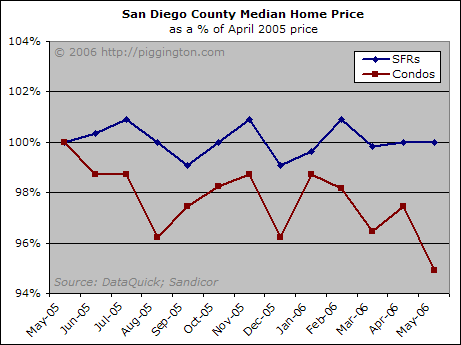
"Actual" Home Prices
I have written before about the shortcomings of the median price as a gauge of home pricing power (most recently in a voiceofsandiego.org article). For all its warts, though, the median is the most timely and readily-available statistic for measuring price movements, so it’s worth looking at. But it’s also worth looking at other gauges as well.
To that end let’s have a look at the Case-Shiller Metro Home Price Index for San Diego. This is a fantastic analytical tool because it normalizes multiple sets of same-unit sales, and further attempts to abstract out improvements and other elements that could have changed the price of a given home. It thus avoids all the problems with the median and gives what I think is the most accurate possible read on broad pricing power. The downside is that it only measures single family homes, and that there is a fairly long lag time to the data. But let’s have a look:
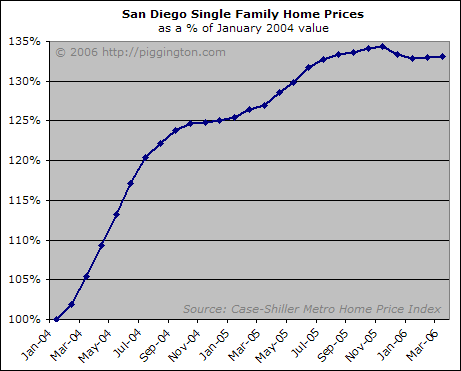
What we can see is that after the spring 2005 rally, home prices rose fairly gently through the end of the year, then fell a bit and flattened out into March of this year. This supports the idea that prices are on their way down.
A couple of points. First, I think it’s no coincidence that the direction of home prices started to reverse after the spike in ARM rates last year. Second, while the index doesn’t tell us what has happened since March, I think we can guess from the weak median price action and the general malaise in the market that the Shiller index will not show any sort of spring rally either.
This will be an important data series to watch in the months and years ahead, because as the market heads downwards the median price may not reflect what’s truly going on.
Incidentally, some of the folks on the forum and elsewhere have stated a belief that prices have been declining since 2004. This may be true for some areas and property types, but the Case-Shiller index shows that in aggregate, San Diego single family homes rose in price well into 2005.
Volume and Inventory
Nothing new here. Volume, despite a bounce from last month, continues to underwhelm and is still down between 25%-30% from this time last year:
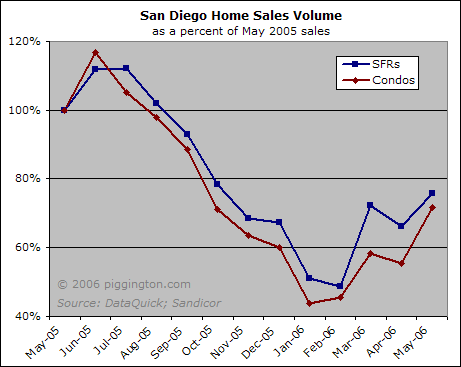
Meanwhile, inventory continues its relentless rise towards the heavens:
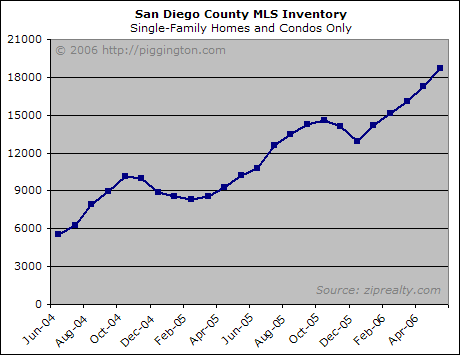
May ended with 5.7 months of inventory listed on MLS. While not awful, that figure is not great either. The problem is that the trend is heading very much in the wrong direction. Inventory downtown, after a period of relative calm, has lately resumed its ascent:
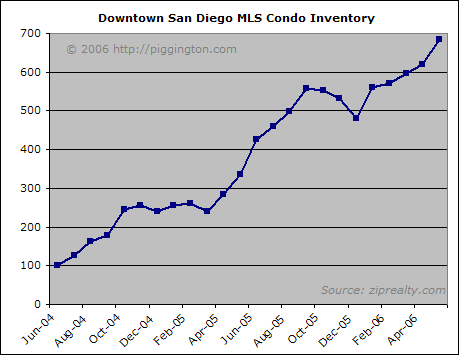
Downtown inventory has more than doubled in the past year, and plenty of new construction is set to come online in the months and years ahead.
San Diego Employment
Looking at recent employment figures, I am surprised to find that the real estate sector still dominates job growth. Housing sales volume is way down and prices have even started to fall, and yet the construction and real estate industry is still almost 5% larger than it was a year ago. The sector experienced a lot of growth from April through August of last year, so unless that happens again, year-over-year comparisons will probably start to look weaker in the months ahead.
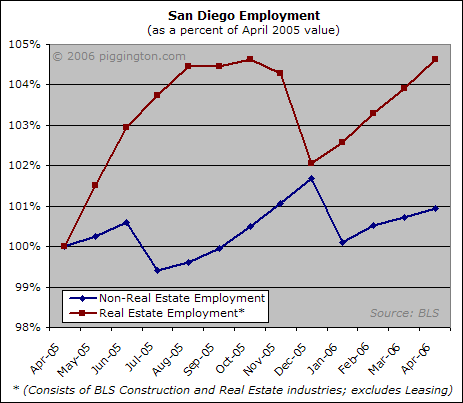
Employment outside of real estate, on the other hand, registered an anemic 1% rate of growth year-over-year.
I thought it would be interesting to take a closer look at retail employment. I’ve constantly harped on the theme that San Diego’s economy had been stimulated by the "wealth effect" as people spent more money due to cashing out home equity or just plain feeling richer. This idea is borne out by the following chart, which shows that the retail sector experienced very rapid growth in recent years when compared to San Diego’s overall employment growth rate of about 1% per year:
As might be expected, retail employment growth reached a peak during the headiest days of the housing bubble in 2004. This growth started to slow down thereafter, and has for the first time in years actually flattened out since late 2005.
Here is a graph of the number of retail jobs during that time period (using 12-month moving average the remove seasonal influences), so that you can observe the cumulative growth:
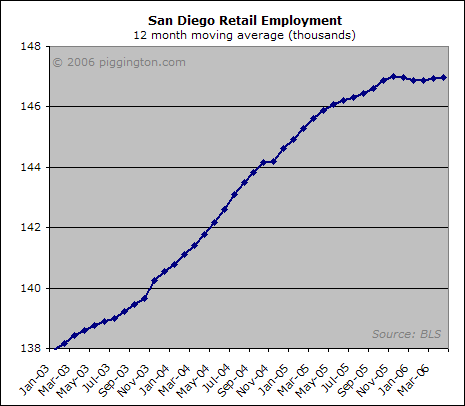
This chart sure looks similar to the chart of Dr. Shiller’s home price index. There is little question that price appreciation provided a huge boost to the retail sector. That stimulus has now been removed.
Mortgage Defaults
All these concerns about future employment and about mortgage payment resets are the types of problems that "won’t matter until they matter." So when do they matter? The best way to gauge that is to look at the economic health of the homeowner population, and the best way to gauge that is by measuring the number of homeowners who are unable to make their payments.
By that measure, a lot more people are running into economic trouble. Notices of Default (NODs, which describe official notices that the borrower is very behind on payments) have increased by an incredible 163% since this time last year. NODs are up by 49% since January alone.
Permabulls will point out that the number of defaults is much lower than it has been during past times of housing market weakness, but that is irrelevant. We are coming from an extremely low rate of default because for the past several years, anyone who had financial trouble simply had to pull out some home equity. Now that price appreciation has slowed, more and more people are finding that they lack the home equity safety net. Meanwhile, loan resets are causing enough economic troubles that some equity-less owners are defaulting.
This trend is only going to strengthen. A very small proportion of loans have reset so far, and the farther in the future a loan resets, the less likely it is to be backed by a home equity safety net (because the more recently someone bought, the less equity they have gained). Meanwhile, the retail employment sector is only now flattening out and the real estate sector has not even slowed down. So as much as NODs have increased in the past year, they are going to increase a lot more.
The important issue, though, is that they have increased. This points to burgeoning financial problems among San Diego homeowners and indicates that economic reality is finally coming into play. People who go into foreclosure (of which the NOD is an initial step) are usually forced to sell, and it is forced selling that really starts to push prices down.
Conclusion
The combination of higher rates, loan resets, excess inventory, and a general decline in demand have started to drive prices lower, and we can finally say with authority that there was no spring rally to save the day. In the months ahead, we will likely experience more downside price movement due to an increase in distressed inventory as more loans reset and the bloated real estate and retail sectors start to come under pressure.
From a longer-term perspective, however, the biggest danger of all is sentiment.
Home prices are usually heavily influenced by fundamental factors: employment, income, supply of homes, etc. But that’s not what’s been going on in San Diego over the past several years. With fairly weak employment outside of real estate, middling income growth, rapid homebuilding, and more people moving out of the city than moving into it, fundamentals have been unimpressive at best. And yet prices positively soared. Why?
The reason, in short, is that people have long since stopped thinking of owned San Diego homes as places to live. For years now, homes have been seen as a way to get rich. People have only been willing to pay these prices because they think San Diego housing will get even more expensive than it is now.
The problem is that this "fundamental" only remains in play for as long as the broad populace believes that home prices will continue to go up. When people realize that home prices are not rising, or are worse yet declining, San Diego homes will once again be looked at simply as places to live. People will start to question whether its worth paying these prices to own, and many of them will decide that the answer is no.
To evaluate short-term price potential, I have concentrated mostly on crosswinds like interest rates, inventory, and sales volume. But those factors pale in comparison to the mighty undercurrent of positive sentiment on which the market has drifted so far from its fundamentals.
I bring this up now because we are now nearing a point where more and more people will start to realize that home prices do not, in fact, always go up. It will take a while—after all, San Diegans have enjoyed an entire decade of astounding home price gains. The idea that financially savvy people own real estate, and lots of it, has become woven into the fabric of our local culture. It’s not going to unravel overnight.
But when we get our first reports of consistent year-over-year declines in the median price, sentiment will start to change faster. And the less optimistic people get, the more downward price pressure there will be… and those falling prices will in turn engender more pessimism. The virtuous cycle of price gains begetting ever more optimism begetting ever more price gains will shift into reverse.
So by all means, watch for the downward pressure from rates, defaults, and the like. As stated above, these look set to cause some problems in both the near term and the longer term.
But watch for a dawning pessimism most of all. The great beast has only just begun to stir, and he will be the dominant force in the years to come. We’ve seen the upside of the historic speculative mania in San Diego housing. It seems that the aftermath is just now getting underway.

